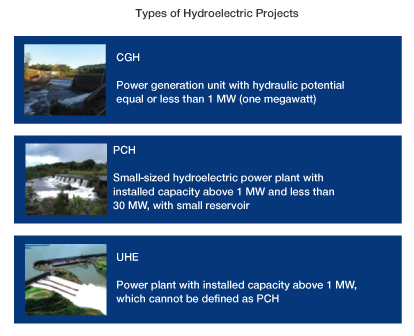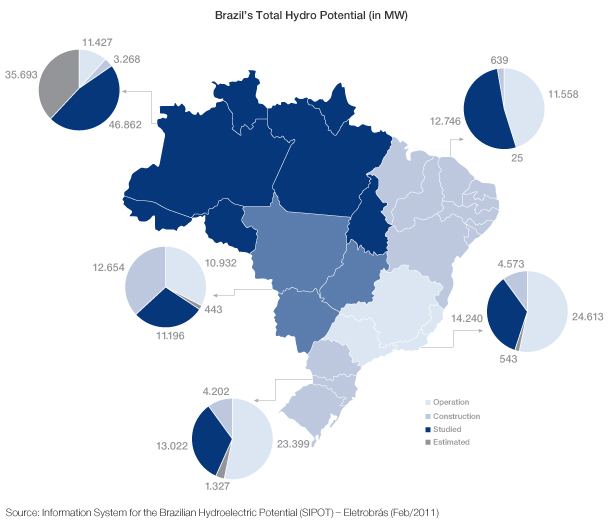Brazil has an extremely privileged river system for hydroelectric power generation. In addition to holding one of the largest bodies of freshwater in the world, the length, width and depth of its rivers are very favorable to the installation of hydropower stations. All these features make it possible for Brazil to position itself, according to the International Energy Agency (IEA), as the country with the highest capacity factor in the world (57 percent versus 42 percent of China and 34 percent of the U.S., for instance).
Hydroelectric power generation in Brazil is currently divided among Central Geradora Hidrelétrica (CGH – Hydroelectric Generation Central), Pequena Central Hidrelétrica (PCH – Small Hydroelectric Central) and Usina Hidrelétrica de Energia (UHE – Hydroelectric Energy Plant). The definitions of each source are listed in the figure below.
Hydroelectricity has over 80 GW installed in the country and is the main source of electricity, accounting for 90 percent of the national power generation and about 70 percent of installed capacity.
Compared to the rest of the world, Brazil stands out among the countries with greater installed capacity and hydroelectric potential, which is estimated at 260 GW. The map below shows Brazil’s hydro potential by region.
According to information from the “Plano Nacional de Energia Elétrica” (National Electric Power Plan), more than 170 GW of the hydroelectric potential is estimated to be technically usable, which places Brazil in third place in the world ranking. Of these, more than 70 percent are located in the Amazon and Tocantins river basins, an area of high environmental interest. Thus, it might be difficult to expand the supply of energy by building new large-scale hydropower plants and, for this reason, in the last few years the PCHs have been steadily increasing their contribution to the energy matrix in Brazil.
There are currently over 400 operating PCHs, corresponding to about 3.3 percent of the total installed capacity in the country. Additionally, approximately 200 PCHs, for a total of over 1,400 MW, are scheduled to become operational by 2015, and 59 of these are already under construction.
A large part of the PCH sector’s appeal lies in the high operational margins achieved with low operations/maintenance costs and in it being a historically highly measurable source, which mitigates the risks of the actual generated power being lower than expected. In addition to these factors, the PCHs provide for an improved supply of power required by smaller urban centers and rural regions, since in most cases it supplements the power supplied by the interconnected system.
Despite the enthusiasm with the PCH sector in the long term, some projects are currently having to overcome a few challenges in the development and construction of the plants. Nowadays, apart from the huge difficulty in obtaining environmental permits, the sector has been struggling with the feasibility of these projects, given the rise in construction costs in Brazil and the low energy prices registered in the latest government auctions (in 2011, the prices registered at nearly R$ 100/MWh).
The biggest challenge in the coming years will be to reduce the high implementation costs for this type of investment, which, according to market players, can fall between R$ 6,000/kW and R$7,000/kW.


